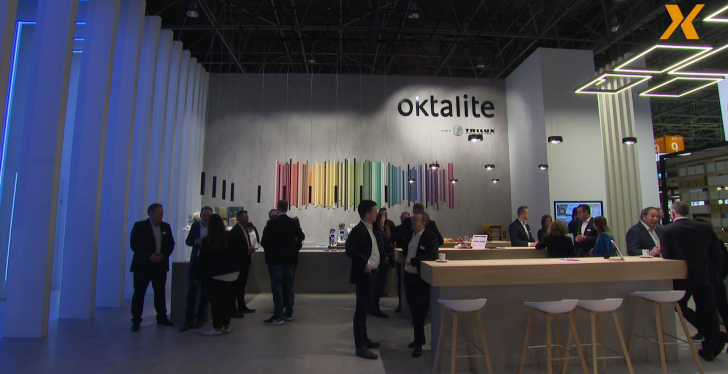Biologically effective lighting in retail
Human-centric lighting benefits employees
panthermedie.net/WavebreakmediaMicro
Over the past ten years, energy efficiency thanks to LED technology has shaped both the lighting market and the retail sector. Lighting became more efficient, smarter and comparable in price with today’s halogen and similar lighting options. Now, the effect of light on the wellbeing of people takes center stage.
Human-centric lighting (HCL) refers to biologically effective lighting that can affect human health in a non-visual, subconscious manner. Sounds complicated but is essentially just a question of adjusting the color temperature to the natural pattern of light during day and night.
Simply put, the blue light components keep people awake by suppressing the sleep hormone melatonin. That’s also why natural, bright sunlight activates more than any artificial light source. Meanwhile, in the evenings, human beings are used to relaxing light with lower intensity. When artificial light disturbs this rhythm, it can have adverse health effects. This has far-reaching implications, especially at the workplace where we spend a lot of our time.
Definition of Human-Centric Lighting (HCL) by ZVEI:
Light has a variety of different and constant – visual, emotional, and biological – effects. Human-centric lighting (HCL) promotes health, wellbeing and the productivity of people in a targeted and long-term manner through integrated planning and implementation of visual, emotional and particularly biological effects of light.

Creating the right working conditions at all times
In a position paper on the use of HCL, the Lighting Association of ZVEI German Electrical and Electronic Manufacturers Association (Zentralverband Elektrotechnik- und Elektronikindustrie e.V.) thus recommends using the new findings on the effects of light on humans sensibly and implementing lighting systems that cater to the biological needs of users. “This lighting concept […] is aimed at always providing users with the type of lighting that matches the respective living and working conditions.“ That means “cooler“ white light during the day and less and “warmer” light at night.
The Association recaps: This type of biologically effective lighting “supports people during periods of activity and periods of rest, regulates the long-term sleep-wake cycle, promotes better sleep and more energy during the day, directly activates and increases motivation and productivity.“
The benefits of HCL have already been proven in studies. For example, a school in Hamburg implemented a lighting concept based on biologically effective lighting in addition to other structural and ergonomic improvements. Students worked faster, with increased concentration and achieved better results thanks to these changes.
Physician and electrical engineer Professor Herbert Plischke of the Endowed Professorship on Light and Health at the Munich University of Applied Sciences describes the mistakes people can make with artificial lighting. “Insufficient blue components (low color temperature) and low light levels during the day can cause fatigue and a ’shift‘ in your body’s internal clock. It is also detrimental to use higher levels of blue components at night (high color temperatures). This suppresses the production of melatonin and disrupts the circadian rhythm.“
What can the retail sector learn from these findings?
Retail can take advantage of this new knowledge in several areas. Undoubtedly the greatest benefits can be achieved in shift and warehouse work because working hours anytime of the day are an increasingly important issue, especially in e-commerce logistics. Customers like to order products around the clock and prefer to have them delivered as quickly as possible. In this case, it’s obvious to create pleasant lighting conditions for warehouse employees, which helps to support their work without disrupting their internal clock.
The picture below shows a comparison of morning, noon and evening light in the German supermarket EDEKA Köpper:

HCL in practical application at EDEKA Köpper
Thomas Köpper, proprietor and managing director of EDEKA Köpper in Niedernwöhren, recently equipped his store with HCL technology. He describes the transformation since he said goodbye to super bright neon lights: “These days we feature lighting that illuminates the products on the one hand while providing decentered, diffused lighting on the other. The special luminaires for human-centric lighting are primarily located in the POS area, the staffroom and in the office spaces. After all, staff members are the ones who benefit most from this change because this is where they spend their working hours. Having said that, our customers are also responding to the new ambiance, which is mostly created by the naturalness of the light and an adjustment to the time of day.“ This is done via an automatic control mechanism that is adapted to the time of day and summer and winter season.
Compared to another store, an accompanying study of the lighting provider observed a considerable increase in sales over a ten-month period. Proprietor Köpper considers the new lighting as very pleasant and feels confident in the benefit of his investment.

More about lighting in retail in our Special:
- 13.11.2017Using lighting systems for indoor positioning
- 13.11.2017The diversity of light
Technical prerequisites – A call for guidelines for the use of HCL
HCL works by dynamically using light with changing brightness and light color. The dimmable luminaires emit diffused light. Even though biologically effective lighting is conveyed through the eyes, it works regardless of the visual process, which is why common prerequisites for installing lighting do not directly apply in this case. According to researchers, this still necessitates guidelines that set standards for the practical use of HCL. To be able to comprehensively use HCL, stakeholders who were interviewed for a study by the Lighting for People organization want more successful examples of users and practical implementation recommendations. What’s more, the main challenge is to make the different components and control mechanisms easy to use and cost-efficient.
That being said, individual lighting companies have already addressed this issue extensively and offer HCL as a product and service. ZVEI points out, “In addition to the visual requirements, today’s lighting planning process should also factor in the non-visual effects of light on people.“ A great incentive for the lighting industry to take this matter seriously and gain a foothold in the retail sector. After all, long-term positive health is an argument that is hard to beat.



